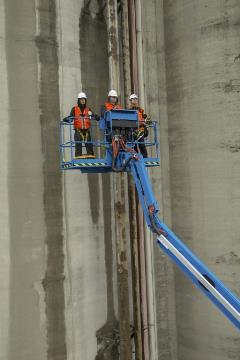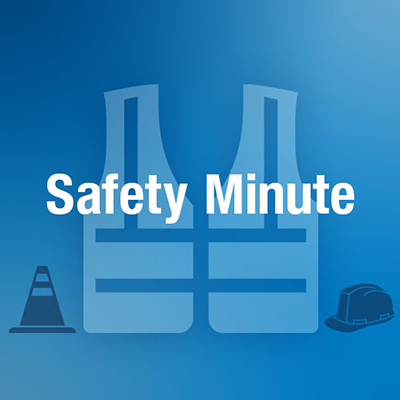Tips for Operating Boom Lifts Above 100 Feet
by Sean Larin - Product Manager On Jul 5, 2018, 03:00 AM
Subscribe To Aerial Pros
Filter by tags
A “Super Boom” was the nickname first given to Genie® boom lifts, breaking through the industry's vertical height ceiling. As mobile elevated work platforms (MEWPs) have since reached even greater heights, some may wonder if there are any additional challenges for the operator. Here are some similarities and differences in operating boom lifts above 100 ft…
Do Your Due Diligence
Super booms provide a safe and productive alternative to hanging crane baskets and passive protection systems for working at height. As with any sized MEWP, it’s essential that the operator is qualified to operate the mobile elevating work platform category. This can be done online, followed by an in-person test and familiarization, through the Genie® Lift Pro™ Operator Training program on a specific super boom model by a qualified person.
Know the Speed Limit
All boom lifts feature a wind speed limit for elevation, beyond which the boom should not be elevated. Proper planning is crucial in preparing for wind, and an anemometer (wind speed monitor) helps ensure that wind speeds remain within a safe range. It’s important to be aware of the impact that height can have on exposure to strong or gusty winds.
Lift With Your Knees
Ever wondered how super booms can reach so high? The secret to their stability lies in their chassis design. For example, all Genie super booms feature the unique patented XChassis™ axle system which can be extended and retracted from the platform controls while driving.
Retracted axles give these large booms a compact width to be easily driven around confined jobsites, similar to smaller booms. When it’s time to reach high, the axles can be extended to provide the stability needed for the work done at the heights up to 180 ft.
Become a Controls Freak
 Genie super booms have very smooth operation, which helps you feel calm and in control when you are elevating high up in the air or stretch far out over an obstacle. However, when working at an extended distance from the drive chassis, it can be difficult to hear what is happening on the ground below. Perspective can also be a challenge if the operator is no longer close to a structure or building.
Genie super booms have very smooth operation, which helps you feel calm and in control when you are elevating high up in the air or stretch far out over an obstacle. However, when working at an extended distance from the drive chassis, it can be difficult to hear what is happening on the ground below. Perspective can also be a challenge if the operator is no longer close to a structure or building.
In this scenario, precision controls and clear machine indicators become more important than ever– particularly if you are nervous about heights. The majority of controls are kept common across the entire Genie boom line up, providing operators with a consistent experience whether operating a small Genie Z®-45 XC™ model or a large SX™-180 unit. For example, you can still find the drive functions in your right hand and boom functions in your left hand, with familiar LED indicators and audible alerts to offer reassurance.
Stay In Great Shape
It’s common for smaller telescopic boom lifts to feature outreach that is around 9 ft less than the tallest platform height. This gives these smaller booms a round, arcing range of motion, known as its “work envelope” or range of motion. The range of motion of super booms tends to be elongated vertically, offering a long horizontal outreach and an even further vertical height. This is important for operators to recognize when planning a job by referencing the differences between the range of motion charts. For instance, a large boom such as the Genie SX-135 XC™ model will not only offer you 90 ft of horizontal reach but also 135 ft of vertical platform height.
Be Incredibly Flexible
Most booms reaching heights greater than 100 ft feature a jib between the operator platform and the main boom section for precise positioning around obstacles at height. Typically, a jib comes in one of three varieties: fixed length, horizontally rotating or extending.
A fixed length jib provides the operator with the ability to vertically raise and lower the platform basket around an obstacle at height, such as the backside of a steel girder. While a horizontally rotating jib enables an operator to reach around the side of an obstacle, such as telecommunication towers, where there may only be one location to park the boom chassis. An extending jib, however, gives operators the ability to reach deep into complex structures from while fully extended, in scenarios such as the complex gas and steam lines.
Now Touch the Sky
This brief introduction gives you insights into the world’s largest articulating and telescopic boom lifts. These super booms can offer simple operation, unprecedented reach and impactful jobsite productivity. If you’re serious about a working knowledge of these super booms, learn more through online operator training classes — Genie Lift Pro™ Training — visit: https://www.genielift.com/en/support/training.
Related Posts

Genie Safety Minute: Lifting a Boom and Scissor Lift
Genie Safety Minute: Lifting a Boom and Scissor Lift
Continue Reading

Follow Special Precautions to Exit a Boom Platform at Height
Articulated and telescopic booms are designed to allow operators to work at varying heights while remaining inside the platform.
Continue Reading


